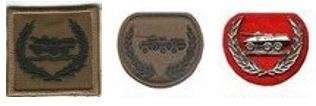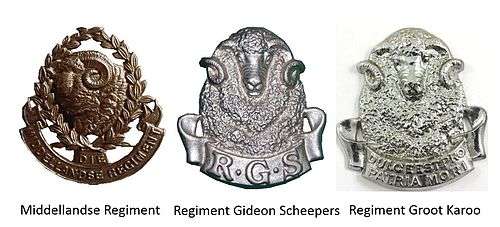Regiment Groot Karoo
| Middellandse Regiment in 1934, renamed to Regiment Gideon Scheepers in 1954, renamed to Regiment Groot Karoo in 1960 | |||||||
|---|---|---|---|---|---|---|---|
|
Regimental badges | |||||||
| Active | 1934 to 1990 - disbanded | ||||||
| Country |
| ||||||
| Allegiance |
| ||||||
| Branch | |||||||
| Type | Mechanised Infantry | ||||||
| Size | Battalion | ||||||
| Part of |
| ||||||
| Garrison/HQ | Graaf Reinet, Cradock, Eastern Cape | ||||||
| Motto(s) | "Dulce Est Pro patria Mori" (It is sweet to die for your country) | ||||||
| Battle honours |
| ||||||
| Disbanded | 1990 | ||||||
| Commanders | |||||||
| Last Commanding Officer | Lt Col H.T.v.G. Bekker | ||||||
Regiment Groot Karoo was an infantry battalion of the South African Army. As a reserve force unit, it had a status roughly equivalent to that of a British Army Reserve or United States Army National Guard unit.
Formation
Regiment Groot Karoo was established in 1934 as one of the new Afrikaans language Citizen Force units of the Union Defence Force.[1] Regiment Groot Karoo has changed it name over its operational lifespan, it was initially referred to as the Middellandse Regiment, then Regiment Gideon Scheepers and finally the regiment Groot Karoo.
The Middellandse Regiment was established as an Infantry battalion with Lieutenant Colonel H.T.v.G. Bekker as its first commanding officer. The Regiment was garrisoned in Craddock, but had sections at Graaf Reinet, Steynsburg, Burgersdorp, Middelburg, Umtata and Aliwal North. The Regiment's first formal training was conducted in East London in 1935 and mainly dealt with the use of the Vickers machinegun. By 1939 however, the Regiment’s headquarters was moved to Graaff Reinet, where a new commander, Lt. Col. W.L. Kingwill was appointed.
World War II
With South Africa’s entry in World War II, the Middellandse Regiment got the opportunity to prove itself. Mobilisation orders was received on 5 September 1940. The Regiment was assigned to the 9th Infantry Brigade and finally to the 2nd South African Division. The Regiment left for Egypt on board the Mauritania on 10 June, arriving in Suez on 22 June and then transported to Mareopolis.
By the middle of August 1941, the Regiment was transported to El Alamein. After 5 October 1941, 2nd South African Division was placed under command of the 8th Army and moved to Bagush. The Regiment was now responsible for anti-aircraft and area defence at the Fuka airfield as well as protecting the railway line and coast between Bagush and Mersa Matruh.
The Regiment was involved in the attack on Bardia between 29 December 1941 and 2 January 1942. A Company of the Regiment was involved in the attack on Sollurn. After the fall of Sollurn, the Regiment moved on to Barrani but had to return to Sollurn to strengthen positions there.
B Company was moved to Tobruk in March 1942 under command of 3rd Brigade. With the eventual fall of Tobruk, 444 members of the Regiment were taken prisoner. Due to the fact that the majority of the Regiment were now prisoners of war, the Regiment was officially disbanded on 6 September 1942, while the remaining members were transferred to Regiment 'President Steyn'. These elements were moved to Quassasin and again reassigned into 1 Rand Light Infantry as the DMR Company, a reference to their previous Regiment. By January 1943, these elements were returned to South Africa.
Reformed
By 1 May 1945 the Middellande Regiment was reformed at Cradock with Lt. Col. Borchers as its new commanding officer. By 1947, the Regiment was again returned to Graaff-Reinet.
By 1953 the Regiment was changed from an armoured vehicle reconnaissance unit to an armoured regiment. During this time the Regiment was also notified that its name was being changed to that of 'Regiment Gideon Scheepers'. The rational was that the previous name had no real purpose except to distinguish it from other units and just indicated a locality where the Regiment originated from. The new name also brought a change in the unit’s insignia, but the merino rams head was retained with it now facing head-on. The laurel wreath was removed and the letters 'RGS' was added. This became effective from 1 January 1954. A new commanding offer, Commandant F.A. Stetzhorn was also appointed.
During 1959 at a commander’s conference at the Eastern Province Command, it was again proposed to change the name of the Regiment back to its original name. That proposal was rejected but the regiment was still renamed to that of Regiment Groot Karoo. This took effect on 1 January 1960. The Regimental emblem remained except the letters on the bottom changed to RGK.
In 1960, the Regiment was ordered to mobilise because of an internal state of emergency in the country. At the same time the Regiment was converted to an armoured-infantry unit.
The Border War
The Regiment participated in the South African Border War, also known as the Namibian War of Independence, as part of 82 Mechanised Brigade. The conflict that took place from 1966 to 1989 in South-West Africa (now Namibia) and Angola between South Africa and its allied forces (mainly UNITA) and the Angolan government, South-West Africa People's Organisation (SWAPO), and their allies, the Soviet Union and Cuba.
Affiliated Division
Insignia
Previous Insignia


Battle honours
- Western Desert 1941-1943
- Bardia
- Gazala
- Alamein Defence
- El Alamein
Insignia
The regimental badge depicts a Merino sheep’s head, in reference to the large scale sheep farming of the area in which it was located.
References
"unknown". Scientia Militaria, South African Journal of Military Studies. 8 (4). 1978.
